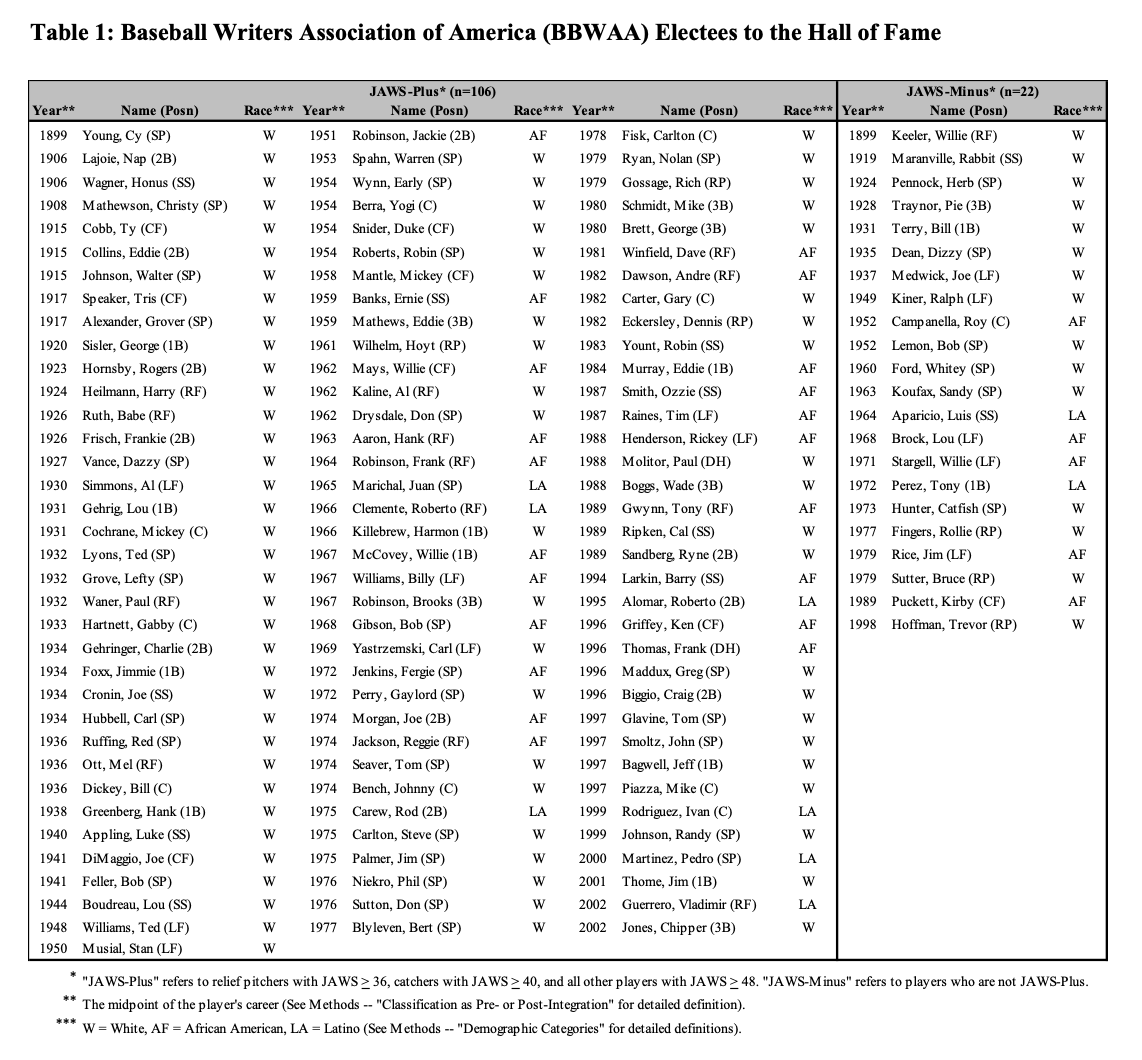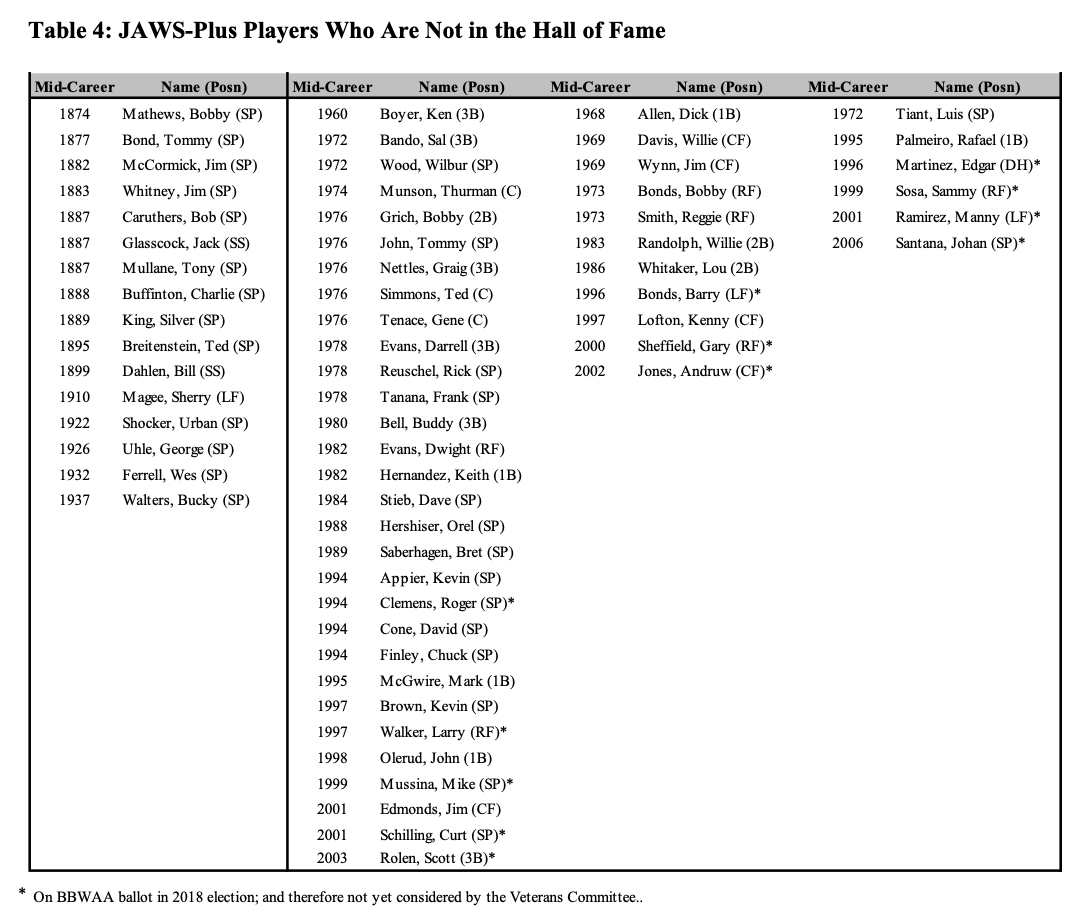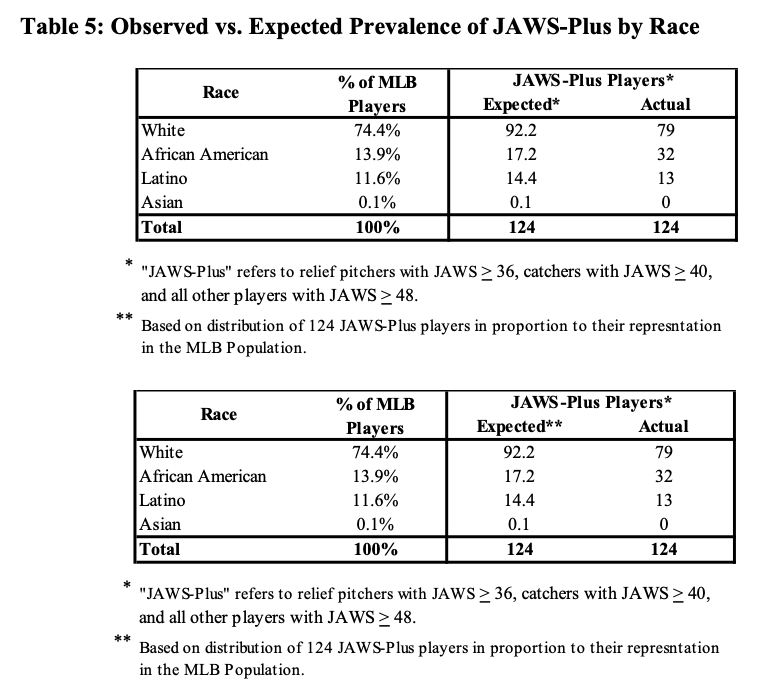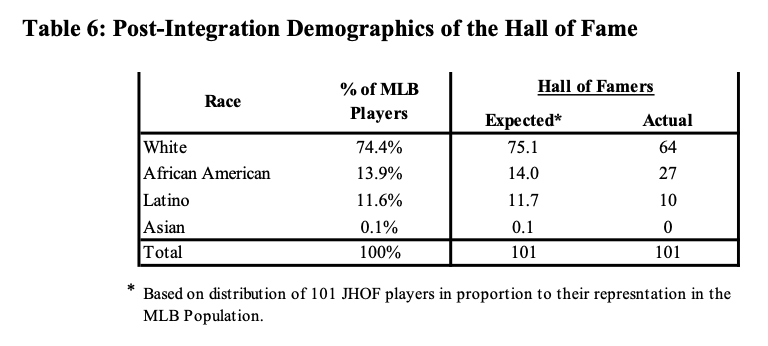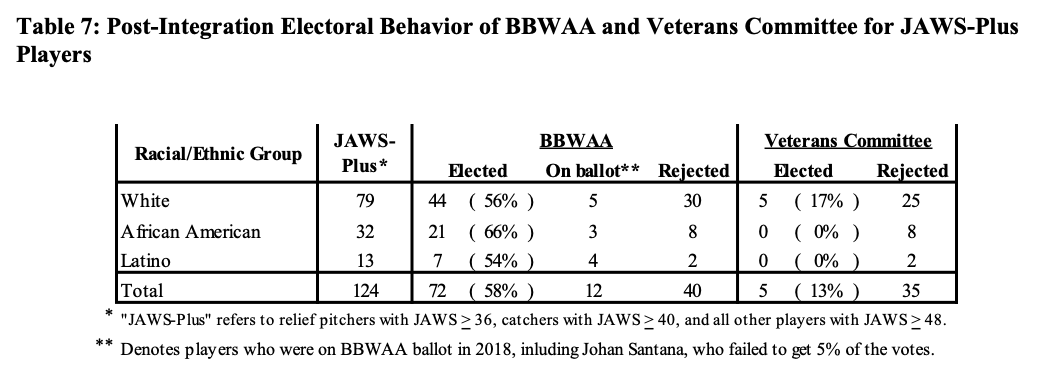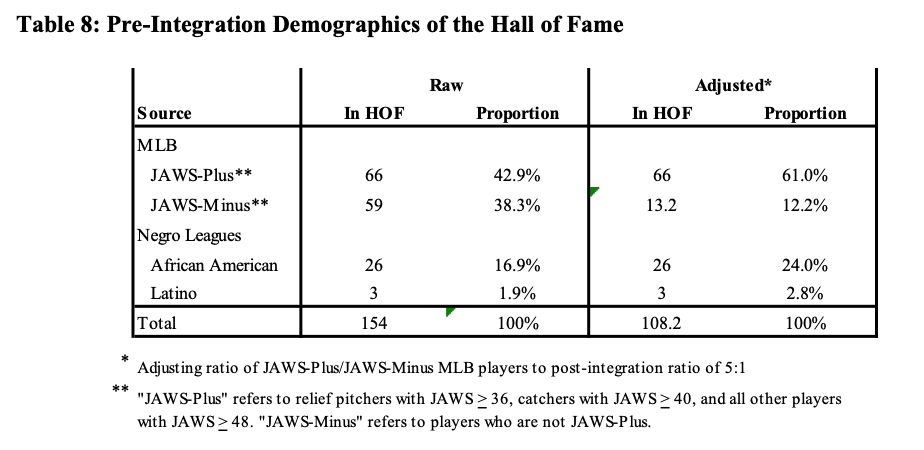Racial Parity in the Hall of Fame
This article was written by David J. Gordon
This article was published in Fall 2018 Baseball Research Journal
Historical Backdrop
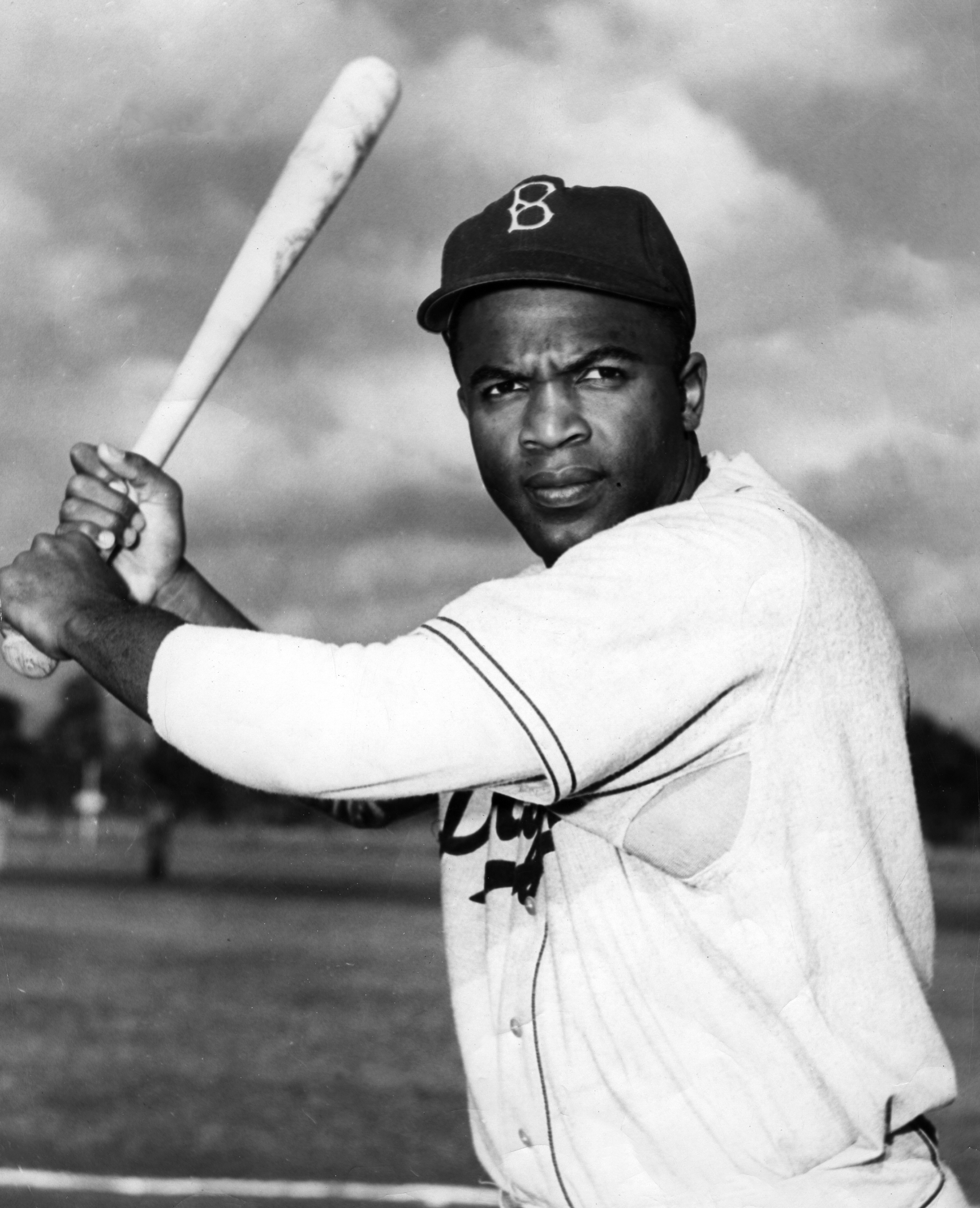 Although the first all-professional baseball organization, the National Association, was established in 1871, only six years after the Civil War, Major League Baseball began with the establishment of the National League in 1876. MLB’s first seven decades took place against of backdrop of Reconstruction, Jim Crow laws, and lynchings, and MLB was a creature of its time. Black players were unwelcome from the beginning. In 1883, Chicago White Stockings team captain Cap Anson refused to let his team take the field for an exhibition game against a Toledo team that employed an African American catcher named Moses Fleetwood Walker.1 Although Anson relented when faced with the loss of his share of gate receipts, incidents of this sort were repeated through the 1880s until there was a de facto ban of players of color from MLB.
Although the first all-professional baseball organization, the National Association, was established in 1871, only six years after the Civil War, Major League Baseball began with the establishment of the National League in 1876. MLB’s first seven decades took place against of backdrop of Reconstruction, Jim Crow laws, and lynchings, and MLB was a creature of its time. Black players were unwelcome from the beginning. In 1883, Chicago White Stockings team captain Cap Anson refused to let his team take the field for an exhibition game against a Toledo team that employed an African American catcher named Moses Fleetwood Walker.1 Although Anson relented when faced with the loss of his share of gate receipts, incidents of this sort were repeated through the 1880s until there was a de facto ban of players of color from MLB.
This ban was enforced through 1946 by a “gentlemen’s agreement” among team owners, with the support of league presidents and, after 1920, Commissioner Kenesaw Mountain Landis.2 The lack of a formal policy enabled Landis to proclaim disingenuously, “There is no rule, formal or informal, or any understanding—unwritten, subterranean, or sub-anything— against the hiring of Negro players by the teams of organized ball.”3 Although widely circulated allegations that Landis scuttled an attempt by Bill Veeck to purchase and integrate the Phillies in 1943 are probably untrue (or at least greatly exaggerated), Landis clearly did not use his power to promote integration during his nearly 25 years as Commissioner.4
Integration of MLB gained traction only after Landis died in November 1944 and was succeeded by former Kentucky Senator Albert “Happy” Chandler, who proclaimed that if black men “can fight and die in Okinawa, Guadalcanal, and in the south Pacific, they can play baseball in America.”5 When Brooklyn Dodgers general manager Branch Rickey signed Jackie Robinson, assigned him to Montreal in 1946, and promoted him to Brooklyn, where he debuted on April 15, 1947, integration of MLB finally became a reality.6
Now that MLB has been integrated for 72 years (about half its history), it is appropriate to ask how black players have fared—not so much in their achievements on the field, which are obviously impressive, but in receiving equal recognition for their accomplishments in the Hall of Fame. There are two aspects to this question:
1. Among players who made their major league debuts on or after April 15, 1947, are black, Latino, and white players with comparable on-field accomplishments equally likely to win election to the Hall of Fame?
2. Does the number of Negro League players chosen for the Hall of Fame in 1971–2006 represent a fair ratio to the number of white Hall of Famers who debuted before April 15, 1947?
METHODS
Classification as Pre- or Post-Integration
The date when MLB was integrated is marked by a bright line on April 15, 1947. The simplest way to delineate between players who belong to the pre- or post-integration eras is by whether the player debuted before Robinson (when segregation was in full force) or afterward, under the new paradigm of racial integration. However, many of the players who debuted before Robinson played much of their careers in the post-integration era. I have calculated the midpoint of every player’s career, defined as the year when that player’s cumulative Wins Above Replacement (WAR) first exceeded half of his eventual career total.7 For the purpose of these analyses, I have assigned every player who reached his career midpoint in 1947 or earlier to the pre-integration category, and every player who reached his career midpoint after 1947 to the post-integration category.
JAWS
To answer the two questions posed above, one needs an objective, race-neutral metric of a player’s credentials for the Hall of Fame. No single metric is perfect for this purpose, but I believe the Jaffe WAR Score (JAWS) is probably the best single published metric available.8 JAWS, which is based on WAR, is derived by adding a player’s total career WAR to the total WAR for his seven best seasons and dividing the sum by two.
JAWS shares many of the limitations of the underlying WAR statistic. It does not consider postseason performance and it systematically undervalues catchers and relief pitchers. I have set the JAWS standard for the HOF to 36 for relief pitchers, 40 for catchers, and 48 for everyone else. Players with JAWS equaling or exceeding these thresholds are deemed JAWS-Plus, while those below these thresholds are deemed JAWS-Minus.
By these standards, there are 206 HOF-eligible JAWS-Plus players, compared to 226 men who were actually elected to the HOF as MLB players (not including managers, executives, umpires, and Negro League players). Although I use JAWS in this article as a dichotomous standard for HOF credentials, I will readily concede that there are some JAWS-Minus players who deserve enshrinement and some JAWS-Plus players who do not. But the JAWS-Plus vs. JAWS-Minus dichotomy is useful to characterize groups of players on the average by a single objective metric, even though it provides only a partial picture of any single player’s HOF qualifications. An additional 29 pre-1947 Negro League players have been elected to the HOF, but detailed statistical records of their careers are lacking and objective comprehensive metrics like JAWS are unavailable. My analysis includes steroid users, but not banned players Pete Rose or the eight banned players from the Black Sox scandal.9
Demographic Categories
Baseball’s segregation policy from the 1880s through 1946 was directed mainly at players of post-Columbian African descent and was based primarily on skin color. Fair-skinned players with Latino ancestry (e.g., Ted Williams, whose mother was Mexican) and American Indians (of whom Baseball Almanac lists 49 examples) were not banned.10 For the purpose of this article, I have followed the US Census demographic classification by race and ethnicity, which divides the population into Hispanic or Latino (persons whose ancestry derives from the Spanish-speaking countries of the Americas and Caribbean, regardless of race), black or African American (non-Latinos with African ancestry, including Canadians and natives of English-, French-, and Dutch-speaking Caribbean islands with African ancestry), and white or European American (non-Latinos of European ancestry).11
Only two American Indians—Chief Bender (Ojibwe) and Zack Wheat (Cherokee)—are in the Hall of Fame; both were JAWS-Minus. The other categories (Alaska Natives, Asians, Pacific Islanders) are not germane to this discussion, since they were never banned from MLB and have produced no candidates for the Hall of Fame. Since the Census allows persons to self-identify, and most Latino immigrants are fluent in English and identify as American in a generation or two, I have counted only players who were themselves born outside the United States or whose parents were born outside the United States as Latino.
Table 1: Baseball Writers Association of America (BBWAA) Electees to the Hall of Fame
(Click image to enlarge)
RESULTS
Members of the Hall of Fame: Tables 1 and 2 list the players elected to the Hall of Fame by the Baseball Writers Association of America (BBWAA) and the various versions of the Veterans Committee (VET).12 The latter body was formed in 1939 as the Old-Timers Committee. From 1953 to 2009 it was known as the Veterans Committee. Since 2010 there have been three separate committees that each focus on a different era. This article uses Veterans Committee as shorthand for the entire process.13
Table 2: Veterans and Old-Timers Commitee (VET) Electees to the Hall of Fame (Players Only)
(Click image to enlarge)
Tables 1 and 2 are subdivided into JAWS-Plus and JAWS-Minus Players. The higher proportion of JAWS-Plus players among BBWAA (83 percent) than VET (38 percent) electees is not entirely surprising, since the BBWAA had the first crack at most post-1900 players, with the Veterans Committee only voting on the “leftovers.” However, the Veterans Committees also had more “relaxed” HOF standards than the BBWAA for pre-World War II players, especially for friends and teammates of ex-players who served on the committee.14 This obvious cronyism had a far bigger impact in the pre-integration era, when 67 percent of Hall of Famers were put there by the Veterans Committee, than in the post-integration era, when only 14 percent were. The large number (59) of JAWS-Minus pre-integration Hall of Famers, 52 of whom were put there by the Veterans Committee, has made the Hall of Fame considerably whiter than it would otherwise be.
Table 3 shows the 29 players elected to the Hall of Fame based on their careers in Negro Leagues. The list includes 26 African American players and three Latino players. Some of them had limited major-league exposure late in their careers; most had no opportunity at all to play in the major leagues.
Table 3. Negro League Players Elected to the Hall of Fame (1971–2006)
(Click image to enlarge)
The nine players elected between 1971 and 1977 were chosen by the Committee on Negro Baseball Leagues. Longtime Negro League manager Rube Foster (1981) and the eight players elected in 1987–2001 were chosen by the Veterans Committee. The remaining 12 players and five executives were chosen by the Special Committee on Negro Leagues in 2006. The interested reader may find more information about these players (including incomplete statistical records) in Lawrence Hogan’s Shades of Glory.15
To complete the picture, Table 4 lists the 63 eligible JAWS-Plus players (as of January 2018) who have not been elected to the Hall of Fame, broken down by era and race.
Table 4. JAWS-Plus Players Who Are Not in the Hall of Fame
(Click image to enlarge)
It is not surprising that there are more such players in the post-integration era, since the post-integration lists include 12 players who were on the 2017 BBWAA ballot and many others who might still be elected by the Veterans Committee, while the HOF window has probably closed for most pre-integration players.
Table 5. Observed vs. Expected Prevalence of JAWS-Plus by Race
(Click image to enlarge)
Racial Parity in the Hall of Fame
Let us now return to our original two questions concerning racial parity in the Hall of Fame. Table 5 compares the number of JAWS-Plus players in each racial/ethnic group in the post-integration era with the number that would be expected if the distribution of JAWS matched the underlying racial/ethnic makeup of MLB. Clearly, it does not. There have been almost twice as many JAWS-Plus black players (32) in the post-integration era as the 17.2 that would have been expected based on the fact that black players comprised about 14 percent of MLB players during this period.16 A statistical test comparing the percentage of black players in the JAWS-Plus group (25.8 percent) with the percentage of black players in MLB during this period yields a Z-score of 3.8 (P<0.001), indicating that black Hall of Famers are significantly more likely than whites to be found in the JAWS-Plus group.17 By contrast, the number of JAWS-Plus Latino players (13) is almost exactly as expected, while the number of JAWS-Plus white players (79) is 86 percent of the 92.2 expected.
There are no eligible JAWS-Plus Asian players yet—and won’t be until five years after Ichiro Suzuki retires. Also, the explosion of the Latino contingent in MLB, from 11.8 percent in 1986 to 27.4 percent in 2016, is only beginning to be reflected in the population of HOF-eligible players. As players like Mariano Rivera, Alex Rodriguez, David Ortiz, Carlos Beltran, Albert Pujols, and Adrian Beltre become HOF-eligible, the increase in JAWS-Plus Latino players is likely to outpace the increase in black or white players.
The disproportionate success of socioeconomically disadvantaged minorities with limited opportunities for advancement elsewhere is not unprecedented in baseball or in other sports. One need only look back to the preeminence of Irish immigrants in nineteenth-century baseball as a prime example. Indeed, of the 41 players in the Hall of Fame who began their careers before 1900, 15 (37 percent) were the sons of Irish immigrants.18 In any case, the remarkable success of black players in post-integration baseball has certainly put the lie to the old canard that they lacked the capacity to compete with white players on the major-league level. Despite Commissioner Landis’s absurd insistence that the absence of black players in MLB for more than 60 years had nothing to do with a deliberate policy of racial discrimination, most MLB executives, like P.K. Wrigley of the Cubs, admitted that their real fear was that attendance by white fans would be affected adversely by integration, and they rationalized that they had to wait for the right time to integrate.19
Having established the disproportionate representation of black players among the best players in MLB during the past 70-plus years, what about their representation in the Hall of Fame? Table 6 shows that black players are at least equally well represented during this period.
Table 6. Post-Integration Demographics of the Hall of Fame
(Click image to enlarge)
Table 6 is parallel to Table 5 and compares the numbers of post-integration white, black, and Latino players in the Hall of Fame to the numbers of each group that would have been expected based on their representation in the MLB population as a whole. Almost twice as many black players (27) from this period have been elected to the Hall of Fame than the 14 who would have been expected based on proportional representation (Z=3.7, P<0.001). Conversely, the number of white players elected to the Hall of Fame in this period (64) is 85 percent of the 75.1 who would have been expected based on proportional representation. The numbers of Latino players (10) and Asians (0) in the Hall of Fame are in line with their representation in the population of all MLB players, although (as in Table 5) the number of Latino players in the Hall of Fame will likely exceed expectations as more of the top Latino players of the past 30 years retire and become eligible for consideration by the BBWAA.
Table 7 addresses the equity of the post-integration Hall of Fame voting process by asking whether the best players of the three major racial/ethnic groups (i.e., the JAWS-Plus players) are equally likely to win election to the Hall of Fame or whether there is a lingering racial bias.
Table 7. Post-Integration Electoral Behavior of BBWAA and Veterans Committee for JAWS-Plus Players
(Click image to enlarge)
The voting process is, of course, sequential. First, players who have been retired for five or more years appear on the BBWAA ballot, whereupon they have up to 10 years (it used to be 15) to be elected or rejected. Rejected players then enter the purview of the Veterans Committee, where currently they are considered in batches of 10 by era, with eras rotating from year to year. The BBWAA has treated black players well, electing 66 percent of JAWS-Plus black players compared to 56 percent of JAWS-Plus white players and 54 percent of JAWS-Plus Latino players. The small black-white difference is not statistically significant (Z = 0.98, 2-sided P = 0.33).20 The BBWAA has also elected five JAWS-Minus black players, as well as eight white players and two Latino players, from the post-integration era. Clearly, African Americans, who comprise one-third of JAWS-Minus post-integration players elected by the BBWAA to the Hall of Fame, are well represented there as well.
However, the report card for the Veterans Committee, which has elected no JAWS-Plus (and only two JAWS-Minus) minority players to the Hall of Fame, is mixed at best. Although the numbers are small due to the tightening of the Veterans Committee’s standards in the past two decades, the committee has elected five of the 30 JAWS-Plus post-integration white players under their purview, as well as seven JAWS-Minus white players. This racial difference in voting patterns is statistically significant (Z=-2.45, 2-sided P=0.014).
Now, one could hypothesize that the reason for that difference may be that the Veterans Committee never gets to consider most of the elite minority players because they have already been elected by the BBWAA, but there are some deserving Hall of Fame candidates among the 10 minority players who have thus far been denied election by the Veterans Committee, including Lou Whitaker, Luis Tiant, Kenny Lofton, and perhaps Dick Allen. If the Veterans Committee had elected only one of these players, the racial difference in voting would not be statistically significant; if they had elected two, we would not be having this discussion at all.
In their defense, we should note that the Veterans Committee did put eight Negro League players in the Hall of Fame between 1987 and 2001, a period during which they also elected six white pre-integration players, of whom only the first four were JAWS-Plus. This seems superficially like a more than equitable distribution, but must be taken in the context that that the Negro Leagues were almost virgin territory at that time, while pre-integration MLB had been well ploughed over before 1987. Indeed, MLB and the HOF had to empanel a special committee in 2006 to finish their work by electing 12 more Negro League players and five executives. This is not necessarily an indictment of the Veterans Committee, since it requires special expertise and a lot of historical research to do the job properly, but it does suggest that the Veterans Committee was less than thorough in the execution of its charge. The Veterans Committee has elected only five players of any era—all of them white—since 2001.
In Table 8, we take a speculative look at the demographics of the pre-integration Hall of Fame.
Table 8. Pre-Integration Demographics of the Hall of Fame
At first, this issue seems like a non-starter, since MLB (with the exception of a few American Indians and fair-skinned Latinos) was all white. However, we can also bring the 29 Negro League Hall of Famers into the discussion. Did the well-intentioned effort by MLB and the Hall of Fame to honor the greatest Negro League players achieve a fair racial balance in the pre-integration portion of the Hall of Fame? We can apply the analytic techniques used above to address this question.
The percentage of black players in the pre-integration Hall of Fame is only 16.9, mainly because of the profligacy of the Veterans Committee in electing 54 JAWS-Minus players (52 white and two American Indian), including 30 from the period between the two world wars. I have addressed this issue by adjusting the pre-integration ratio of JAWS-Plus to JAWS-Minus Hall of Famers to match the 5:1 ratio of the post-integration era. So, without specifying which players to remove, we are left with 13 instead of 59 JAWS-Minus pre-integration Hall of Famers, in addition to 66 JAWS-Plus pre-integration Hall of Famers. So, when the 29 Negro Leaguers are added in, you now have 24 percent of the pre-integration Hall of Famers being black players—a percentage that is not very different from the 27 percent in the post-integration era.
The percentage of Latinos (three percent) in the “adjusted” pre-integration era is of course far less than the post-integration 10 percent, reflecting the fact that Latinos represented only about one percent of the US population at that time.21 In short, the pre-integration “shortfall” in the percentage of black players in the Hall of Fame is more reflective of the surplus of JAWS-Minus pre-integration white players elected by the Veterans Committee than a paucity of Negro League honorees. That being said, some worthy Negro Leaguers are still out there, and the HOF can probably accommodate a few more.22
SUMMARY
It is abundantly clear that black players have succeeded in MLB far beyond what would be expected given their numbers. This will hardly surprise anyone who has been paying attention during the past seven decades. But it is less obvious and quite reassuring that the BBWAA voters (but not necessarily the Veterans Committee) have been even-handed in giving deserving black players of the post-integration era their full due in the Hall of Fame and even honoring five black (vs. eight white and two Latino) JAWS-Minus players. The Hall of Fame and MLB also stepped in to mitigate the injustice of prior racial segregation by recognizing many highly deserving Negro League players in the Hall of Fame, although no one can fully redress the injustice of so many promising careers that either never happened or happened in relative obscurity. Still, recognition in the Hall of Fame is an important step for descendants of these players and their fans, if not for the players themselves.
This analysis does not address the 23 managers, 35 pioneers/executives, and 10 umpires (68 members in all) who have been elected to the Hall of Fame, whose accomplishments cannot be encapsulated in a statistical metric. The list of honorees includes several MLB executives (led by Commissioner Landis) who were complicit in implementing and maintaining the “gentlemen’s agreement” to segregate MLB or who were slow to hire black players after integration. It might be appropriate for the Hall of Fame to consider removing or at least adding an asterisk to a few of those plaques. On the other hand, the Hall of Fame can be proud to have honored a few boat-rocking executives and managers (Chandler, Rickey, Veeck, Durocher)—the real “gentlemen”—who had the courage to stand up for the integration of MLB in the 1940s.
DAVID J. GORDON is a native Chicagoan who grew up in the 1950s within earshot of Wrigley Field. After graduating from the University of Chicago, he moved to Chevy Chase, MD and spent 43 years in public health and biomedical research at the National Institutes of Health. In retirement, he has come full circle to write a historical book on major league baseball and its greatest players. Dr. Gordon is married (Susan) and has two adult children (Sam and Emily).
Notes
1. David Fleitz, “Cap Anson,” SABR Biography Project, https://sabr.org/bioproj/person/9b42f875.
2. Wikipedia. Kenesaw Mountain Landis. https://en.wikipedia.org/wiki/Kenesaw_Mountain_Landis#cite_note-FOOTNOTEPietrusza406-141.
3. Lawrence D. Hogan, Shades of Glory (Cooperstown, NY: National Baseball Hall of Fame, 2006), 331–32.
4. David M. Jordan, Larry R. Gerlach, and John P. Rossi. “A Baseball Myth Exploded, https://sabr.org/cmsFiles/Files/Bill_Veeck_and_the_1943_ sale_of_the_Phillies.pdf, accessed September 2018.
5. Hogan, Shades of Glory, 334.
6. Andy McCue, “Branch Rickey,” SABR Biography Project, https://sabr.org/bioproj/person/6d0ab8f3; Rick Swaine, “Jackie Robinson,” SABR Biography Project, https://sabr.org/bioproj/person/ bb9e2490.
7. “WAR Explained,” Baseball-Reference, https://www.baseball-reference.com/ about/war_explained.shtml.
8. Jay Jaffe, The Cooperstown Casebook (New York: St. Martin’s Press, 2017), 22–27.
9. Andy Sturgill, “Pete Rose,” SABR Biography Project, https://sabr.org/bioproj/person/89979ba5; Eliot Asinov, Eight Men Out: The Black Sox
and the 1919 World Series (New York: Henry Holt & Company, 1963).
10. “American Indian Baseball Players,” Baseball Almanac,
http://www.baseball-almanac.com/legendary/american_indian_baseball_players.shtml, accessed August 2018.
11. “Demographic Trends of the 20th Century,” US Census Bureau, Figure 3.3, 77, November 2002, https://www.census.gov/prod/ 2002pubs/censr-4.pdf; “Hispanic or Latino origin,” US Census Bureau, https://factfinder.census.gov/help/en/hispanic_or_latino_origin.htm, accessed August 2018.
12. “Hall of Famers by Election Method,” BaseballHall.org, https://baseballhall.org/discover-more/stories/hall-of-famer-facts/hall-of-famers-by-election-method, accessed August 2018.
13. Wikipedia, Veterans Committee, https://en.wikipedia.org/wiki/ Veterans_Committee, accessed September 2018.
14. Jaffe, The Cooperstown Casebook, 48–61.
15. Hogan, Shades of Glory.
16. Mark Armour and Daniel R. Levitt, “Baseball Demographics, 1947–2016,” SABR, https://sabr.org/bioproj/topic/baseball-demographics-1947-2012.
17. “One-Sample Z-Test for Proportions,” Free Statistics Lectures, http://www.statisticslectures.com/topics/onesamplezproportions.
18. The 15 were Jim O’Rourke, Pud Galvin, King Kelly, Dan Brouthers, Mickey Welch, Tim Keefe, Tommy McCarthy, Ed Delahanty, Hugh Duffy, George Davis, Joe Kelley, Willie Keeler, Jimmy Collins, Roger Bresnahan, and Joe McGinnity. The SABR Biography Project has biographies of all but Brouthers, searchable at https://sabr.org/bioproj_search; For Brouthers: Roy Kerr, Big Dan Brouthers: Baseball’s First Great Slugger (Jefferson, NC: McFarland, 2013), 4.
19. Hogan, Shades of Glory, 332.
20. “Z-Test for Proportions, Two-Samples,” Free Statistics Lectures, http://www.statisticslectures.com/topics/ztestproportions.
21. “Demographic Trends of the 20th Century,” US Census Bureau; Graham Womack, “Baseball Hall of Fame Could Do More for Negro Leaguers,” The Sporting News, February 27, 2017, http://www.sportingnews.com/us/mlb/news/negro-leaguers-in-the-baseball-hall-of-fame-cooperstown-buck-oneil-gus-greenlee/1p766f7lpmxio1x06l6lv0qkry.



